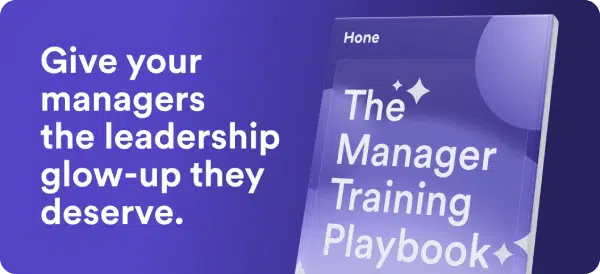Grit. It provides traction when your wheels are stuck so you can get out of a tough spot and back on the road. Without grit, you’re just spinning your wheels and going nowhere. More metaphorically, grit is the ability to put your head down and get important things done even in the face of adversity and setbacks. Author and researcher Angela Duckworth describes grit as passion combined with perseverance. To lead with grit is more important than ever, but it can be elusive. Infusing your team with grit is both critical and challenging.
Even if you’re well acquainted with grit, you probably see behaviors in your team that benefit from a bit more grit. So, how gritty is your team, anyway? Do they find fulfillment in working hard together to solve big problems or do they languish in the face of adversity? How can you assess individual and team grit? What indicates your team is getting more gritty over time?
In this blog, you’ll learn how to listen deeply and inspire others during change. What you discover by listening will drive how you adapt and help your team band together behind a shared purpose. We’ll also describe the key behaviors that inspire greater collaboration and innovation amidst turbulence.
How to Leadership Coach Your Team’s Strategies and Lead with Grit
Grit is intangible and difficult to capture cleanly like other amorphous concepts such as culture or motivation. It’s the culmination of a million tiny decisions and actions that usually feel organic in the moment.
Unlike clear-cut training on A/B testing, the latest agile tip, or a review of the latest changes to accounting rules, teaching your team about grit requires different manager muscles than you may be used to exercising.
So, how do you introduce the concept of grit to your team and make it concrete and real for each individual? Let’s look at a few key strategies.
1. Talk openly about grit
Step one is introducing the concept of grit so everyone has the same mental construct. There are plenty of resources on grit to make this part easy. Start by sharing Duckworth’s well-known TEDtalk with your team and ask them to watch it before your next team meeting. For teams with avid readers or audiobook listeners, managers might recommend Duckworth’s book on grit or one of the podcasts she’s appeared on.
At the team meeting, ask colleagues to share what they learned about grit. Instead of lecturing you’re facilitating a conversation to tease out what people understand and ensure a common understanding.
Next, ask your team to share stories demonstrating grit. Be thoughtful about your organization’s culture around sharing. Some teams will immediately gravitate toward personal stories while others will feel uncomfortable sharing something that feels vulnerable. The stories do not need to be personal. A participant can talk about a time they observed someone else being gritty or a story from sports or the world of entrepreneurship.
The function of storytelling is to pull out memorable details. What exactly was gritty at that moment? What choices showed grit? How did they consider tradeoffs? How did their grit affect others?
Grit isn’t just pushing yourself to your mental and physical limits; that is not sustainable. Sometimes grit is about showing up every day and making 30 cold calls or tackling the bug backlog or doing that last double-check to ensure the report is accurate. Grit should feel more like an achievable trait than death-defying heroism.
Finally, have your team take Duckworth’s grit quiz and discuss or personally reflect on the results. Again, depending on your organization’s culture, it may not be appropriate for each person to share their own, but you can ask teammates to reflect on their scores.
Was it higher, lower, or about what they had anticipated? What thoughts did their score bring up? Self-reflection is the first step in changing any behavior, and that is what you as a leader are creating space for.
A word about grit and equity
Much of the initial research and interest in grit comes from the world of elementary and secondary education. Duckworth herself spent time as a classroom teacher. Grit’s prominence beyond the classroom and into the broader public was an outgrowth of the charter school movement.
A New York Times bestseller by Paul Tough highlights the application of a curriculum focused on grit in the KIPP charter school network. Subsequent and nuanced criticism pointed out an overemphasis on grit and personal responsibility without adequate recognition of the role poverty, racism, and structural inequality play in the lives of KIPP’s target student population.
For this reason, some colleagues may have strong and personal reactions to a discussion of grit in the workplace. Duckworth addresses this in a statement. In short, it is a both/and situation. Research shows that grit improves outcomes but it is not a solution for structural inequalities. Just like any other tool in the managerial toolbox, grit will not be the solution to every problem. But it can help us to reach our goals and feel better while doing so.
2. Focus on what passion is (and isn’t)
Passion + perseverance = grit. So it is important to be clear about what passion is and is not. In the age of “quiet quitting,” and the renegotiation of boundaries between work and life post-pandemic, declarations about displaying passion about work from a manager may be met with skepticism.
No, you are not expecting your mechanical engineers to be deeply passionate about designing the casing for a new power supply. Your team is made up of well-rounded human beings who have lives outside of work. But, they do spend a significant portion of their life at work, so for that time, isn’t it preferable to be interested and engaged?
Now introduce your team to the passion continuum shown below. The left-hand third of the continuum is “curiosity” and interest. The middle third turns up the volume to “engaged” before the right-hand third becomes “passionate.” Some colleagues may struggle to identify what they are passionate about, but can usually identify when they have been curious and interested at work.
The goal is to understand your direct reports’ answers to the questions below, recognizing that the focus is on making steady progress to the right end of the continuum. A great place to work through some of these questions is a regular 1:1 meeting.
3. Adopt and foster a growth mindset
All this focus on how to lead with grit presupposes that humans are capable of change. After all, if everyone was simply an unchangeable collection of intelligence and personality traits, there is no need to talk about grit at all.
Research, however, shows that people can and do grow and change what they know, how they think, and how they behave. In short, people are capable of growth and it’s linked to feeling satisfied with life.
Carol Dweck is the researcher most often credited with popularizing the idea of the growth mindset and its impact on learning. She and her team observed that young students praised for their inherent smarts gave up when confronted with more challenging tasks. They assume they must not be smart enough to complete it. In contrast, students praised for their effort and perseverance in completing tasks and worked harder and longer at more challenging ones.
Adopting and promoting a growth mindset pushes us outside of our comfort zones. But with support and time, these new skills will begin to feel more natural. You might mention taking up a new hobby for which you have no natural talent, but that you enjoy learning and improving. Or point out to a junior teammate who just assigned a stretch goal that you know their hard work will help them reach. Growth mindset underpins most successful change management strategies, so it is worth making it part of your vocabulary.
4. Free yourself and your team from perfection
A growth mindset goes hand-in-hand with accepting that failure is an inevitable part of learning or doing something new. David Kelley, founder of design and consulting company IDEO, is credited with the phrase “fail faster, succeed sooner.” It’s become a core mantra in the world of agile. What makes “fail faster” memorable is its counterintuitiveness–who wants to fail? However, this one phrase encapsulates that on the way to success, failure is inevitable.
Fear of failure at work often looks like playing it safe, not speaking up for fear of criticism, and getting swept up in groupthink. These are all things every organization focused on innovation should be keen to avoid. Sharing openly about your own failures is a good way to start.
Recognize you made decisions with the information available at the time so now translate what you learned into lessons into future success. Strong managers will coach their perfectionists to let go of the always A+ mindset by also recognizing the double-edged nature of perfectionism. Often the very perfectionism enabling high performers to do well at work is the same thing holding them back.
Accepting and normalizing failure looks like regular post-mortems on projects (regardless of outcome). It means asking struggling teammates to identify what they learned and how they will apply it in the future. It also includes initially digesting failures in private 1:1s rather than in group settings. Leaders capable of recognizing the valuable role of failure will unleash creativity and innovation–commodities in hot demand.
5. Celebrate gritty moments
Grit shows up differently depending on your organization. To promote your own flavor of grit, make sure to highlight moments featuring it. Those aren’t always the moments of obvious success, such as when a new salesperson closes a big deal after more than a year of patient persistence. A gritty moment might be when a colleague scrambles to give a major presentation to a big client solo when the rest of the team gets stuck in a snowstorm. Or when the customer service representative keeps pushing forward to solve a complex customer problem. Whatever version of grit you want to see more of should guide what you recognize and celebrate for their grit.
2 Frameworks for Leadership Coaching with Grit
You now have a sense of what grit is and some ideas on how to promote it with your team. The following frameworks provide a structure for making grit a concrete part of how your team works together. Adopting a framework and applying it over time can drive the consistency of the message. It takes grit from a management buzzword to an authentic value of your team.
1. GRIT Framework
Paul Stoltz identified four dimensions of grit, leveraging the word into a mnemonic:
- Growth (mindset). A propensity to seek and consider new ideas, alternatives, approaches, and fresh perspectives.
- Resilience. The capacity to not only bounce back from adversity or failure but also to deal with adversity constructively, turning an unsuccessful experience into “fuel” for increasing one’s effort in the next attempt.
- Instinct. The innate desire to pursue the most worthy goals in the smartest ways.
- Tenacity. Persistence toward the goal, in spite of difficulty or discomfort.
This takes an elusive concept like grit and makes it more concrete. Calling out and recognizing when a teammate has demonstrated a growth mindset, resilience, instinct, or tenacity will instill these ideas as part of your gritty team culture.
2. WOOP Model
Gabriele Oettingen’s work on positive motivation culminated in the WOOP Model. WOOP is a science-based mental strategy people use to find and fulfill their wishes, set preferences, and change their habits. To use the WOOP Model, the user must define the following:
- Wish. What is the challenging yet feasible thing you want to achieve?
- Outcome. What would be the best outcome of fulfilling your wish?
- Obstacle. What is the main obstacle holding you back from fulfilling your wish?
- Plan. What can you do to overcome your obstacle?
The WOOP Model works for any sort of goal setting, personal or professional. It’s simple enough to learn and teach to others quickly. It’s good for long-term or short-term goals of any size. There’s a web app, an iOS mobile app, an Android app, and a downloadable kit for those who like offline printables.
Leadership Coaching with Grit at Google
Get good enough at something that people will be curious about how you did it. That’s exactly what happened at Google. In 2012, Google embarked on the two-year-long Project Aristotle to discover what makes great teams. They studied 180 real and diverse teams at Google, conducted more than 200 interviews, and analyzed 250 team attributes.
Project Aristotle Definition of a Team
Like all good researchers, Google defined what a team is. While many different definitions and frameworks exist, Google settled on highly interdependent work groups that plan work, make decisions, and review progress on a specific project and need each other to complete the project.
Project Aristotle’s Five Dimensions of Successful Teams
The Project Aristotle team defined five dimensions of successful teams. In order of descending importance, they are:
- Psychological safety. The Google researchers found this factor leads all others in terms of importance. Psychological safety is present when team members feel safe to take risks and be vulnerable in front of each other.
- Dependability. Team members get things done on time and meet Google’s high bar for excellence.
- Structure and clarity. Team members have clear roles, plans, and goals. Objectives and key results (OKRs) are often used at Google to provide structure and clarity around goals.
- Meaning. Work is personally important to team members. This doesn’t mean every successful teammate finds their life’s meaning in writing code. But it does mean they’ve identified a personal reason for working, such as financial independence, supporting family, or contributing to a team.
- Impact. Team members think their work matters and create change. The most mundane activity can be connected to a broader, organization-wide goal. Making that connection is an important skill for leaders. Ensuring your team knows how their work impacts company goals increases team cohesion.
Next Steps for Leadership Coaching Your Team on Growing Grit
The benefits of cultivating grit in your team are clear. Before jumping in with both feet, take some time to reflect on your own relationship with grit and how it could improve. Sharing ideas like the growth mindset and letting go of perfectionism is great. But it will ring hollow if your actions don’t align with what you’re preaching.
Spend some time thinking about your team. Where would more grit be helpful? What is one small shift you can make and follow through with to cultivate more grit on your team? With some thoughtfulness and the strategies outlined here, you will be able to add yet another tool to your leadership coaching toolbox. For more support in growing your leadership coaching knowledge, check out Hone.













